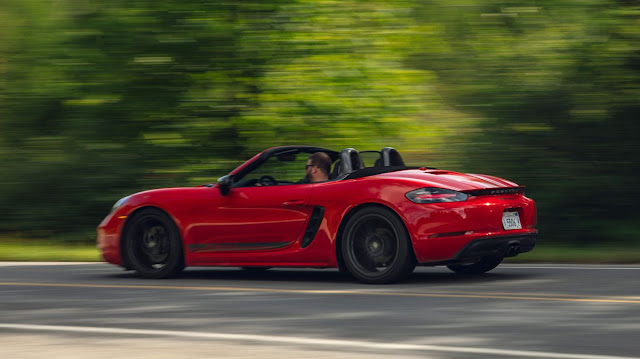2024 Porsche Cayenne Turbo E-Hybrid Is One Wild Animal
It's big and heavy and surprisingly fleet.
The 2024 Porsche Cayenne Turbo E-Hybrid is the hippopotamus of high-performance mid-size luxury SUVs. It's big and heavy, incredibly powerful, and shockingly quick.
As its name implies, the Cayenne's Turbo trim doesn't rely solely on a twin-turbocharged 4.0-liter V-8 engine for motivation. Rather it takes a page from the outgoing Cayenne Turbo S E-Hybrid, stuffing an electric motor in between its bi-turbo bent-eight and eight-speed automatic transmission. For now, it's the most potent Cayenne hybrid, although we'd wager that Porsche will revive the Turbo S nameplate and pin it to an even more extreme version sometime soon.
Punchy Powertrain
The specific badging Porsche affixes to its top Cayenne E-Hybrid model matters less than the output its powertrain produces, and the peak 729 horsepower the Turbo E-Hybrid cranks out betters last year's Turbo S E-Hybrid by 59 horses. Tweaks to the V-8 engine add 50 ponies to its stable for a total of 591 horsepower, and a more powerful electric motor pumps out 174 horses—40 more than the old Turbo S E-Hybrid's. Blame the gas engine's 6000-rpm power peak for the 36 horses that get lost totaling up the Turbo E-Hybrid's combined power figure.
The electric motor does a reasonable job pushing the hefty Turbo E-Hybrid off the line or through low-speed city traffic. With a peak of 339 pound-feet of torque, it even has enough oomph to get the plug-in Porsche up to 84 mph without the aid of the gas engine.
Range and Drive Modes
Estimated electric-only range from the lithium-ion battery pack (21.8 kilowatt-hours of usable capacity) should top 30 miles once the EPA gets around to rating it. But driving the Turbo E-Hybrid in its default E-Power (EV) mode is akin to putting a wild animal in captivity. To free the beast within, you need to turn the steering-wheel-mounted drive-mode switch to Hybrid, Sport, or Sport Plus (or, if you're venturing off pavement, to Offroad).
Hybrid is something like a safari park; the electric motor is still the primary motivator, but just a small prod of the accelerator brings the gas engine into the mix. Sport and Sport Plus, meanwhile, open the park gates and let the Turbo E-Hybrid embrace its savage nature. They keep the gas engine at the ready for instant access to the SUV's prodigious power.
Whereas E-Power and Hybrid modes leave the standard two-chamber air springs in their Normal mode, Sport and Sport Plus place the suspension in its firmer settings. Lapping Spain's 2.6-mile Parcmotor Castellolí (Circuit Parcmotor) near Barcelona, Sport mode kept the air springs taut enough to limit excess body motions while retaining just enough compliance to maintain composure over the most undulating stretches of pavement.
Turbo E-Hybrid Performance
Both the $148,550 Turbo E-Hybrid SUV and $153,050 fastback Coupe models should weigh about 5700 pounds once we get them on our scales. Unsurprisingly, these big Porsches were at their best when pointed straight ahead. Although the Spanish track's two straightaways were too short to confirm the claimed top speed of 183 mph, they were plenty long enough to indulge the seemingly endless wave of power produced by the electric motor and eager-revving twin-turbo V-8.
Porsche claims the Turbo E-Hybrid will pummel its way to 60 mph in 3.5 seconds. But we recorded a 3.2-second run to 60 in a similarly heavy but less powerful 2020 Cayenne Turbo S E-Hybrid, so we think the Turbo E-Hybrid has the potential to be even quicker.
Despite its mass, the Turbo E-Hybrid tore through Parcmotor Castellolí's 11 turns with fervor. Credit the optional 22-inch wheels wrapped in grippy summer rubber, which stood in for the standard 21-inch wheels and all-season tires. Porsche also offers 21-inch summers as a no-cost option.
Plentiful grip, light and direct steering that weighed up predictably as we added input, and a clairvoyant ZF eight-speed automatic gearbox that held gears through corners all came together to push the Turbo E-Hybrid around each apex. Turning in with just a bit of extra speed revealed some understeer at the limit. Goading the accelerator just past the apex was enough to gently push the tail out before the torque-vectoring rear-end and all-wheel-drive system brought the rear axle back in line.
Braking the Turbo E-Hybrid
Porsche fits a set of 16.5-inch front and 14.4-inch rear rotors clamped down by 10-piston front and four-piston rear calipers to the Turbo E-Hybrid, and the combination was more than up to the task of slowing the big SUV during our spirited drive on the mountain roads near Parc Natural de la Muntanya de Montserrat (Montserrat Mountain Natural Park).
The Turbo E-Hybrid we drove on the track wore optional carbon-ceramic brakes with even larger rotors measuring 17.3 inches up front and 16.1 inches out back. The $9080 brake option showed no signs of fade even after multiple sessions. On surface streets, however, the carbon-ceramic brakes' grabby nature at lower speeds made it difficult to come to a stop smoothly, exacerbated by the uncouth handoff between regenerative and mechanical braking. The standard cast-iron stoppers suffered from no such clumsiness.









